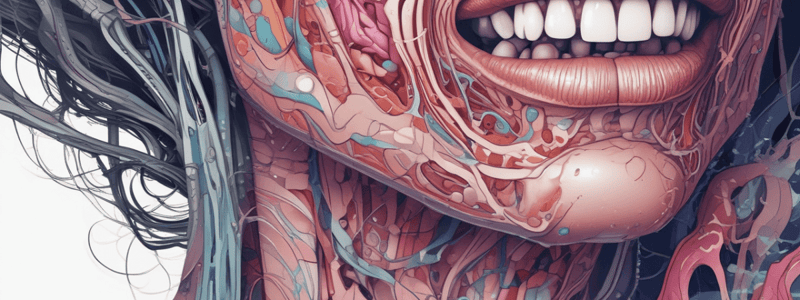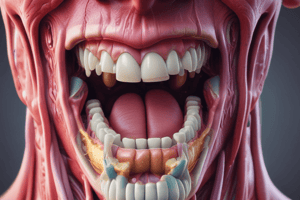Podcast
Questions and Answers
What is the characteristic of oral cancer?
What is the characteristic of oral cancer?
- Occurs mainly in males
- Typically involves the liver
- Involves the large intestine
- Tends to spread rapidly (correct)
Where does an inguinal hernia protrude in males?
Where does an inguinal hernia protrude in males?
- Into the stomach
- Into the kidneys
- Into the scrotum (correct)
- Into the lungs
Which disease is the fourth leading cause of cancer deaths in the U.S.?
Which disease is the fourth leading cause of cancer deaths in the U.S.?
- Oral cancer
- Stomach ulcers
- Stomach cancer
- Pancreatic cancer (correct)
Where does stomach cancer commonly occur?
Where does stomach cancer commonly occur?
What is the location where an inguinal hernia protrudes?
What is the location where an inguinal hernia protrudes?
What is a characteristic of stomach ulcers?
What is a characteristic of stomach ulcers?
Which disease involves a breakdown in the lining of the stomach?
Which disease involves a breakdown in the lining of the stomach?
What is a common characteristic of pancreatic cancer?
What is a common characteristic of pancreatic cancer?
What part of the body does oral cancer usually involve?
What part of the body does oral cancer usually involve?
¿Qué acción no está permitida con respecto al documento mencionado?
¿Qué acción no está permitida con respecto al documento mencionado?
Según el documento, ¿cuál es la única razón por la que se permite el uso del material?
Según el documento, ¿cuál es la única razón por la que se permite el uso del material?
¿Cuál es la cita final del documento proporcionado?
¿Cuál es la cita final del documento proporcionado?
¿Qué parte del cuerpo está específicamente relacionada con el texto proporcionado?
¿Qué parte del cuerpo está específicamente relacionada con el texto proporcionado?
¿Qué se menciona como una característica común de las enfermedades del sistema digestivo?
¿Qué se menciona como una característica común de las enfermedades del sistema digestivo?
¿Cuál es la afirmación correcta sobre las enfermedades digestivas según el texto?
¿Cuál es la afirmación correcta sobre las enfermedades digestivas según el texto?
¿Qué tipo de información se prohíbe expresamente compartir en cuanto al documento?
¿Qué tipo de información se prohíbe expresamente compartir en cuanto al documento?
¿Qué se sugiere al final del documento como clave para mantener la salud?
¿Qué se sugiere al final del documento como clave para mantener la salud?
Flashcards are hidden until you start studying
Study Notes
The Mouth
- Salivary glands produce serous (watery) fluid and amylase (enzyme) and mucous (thick, protective) fluid.
- There are three types of salivary glands: parotid, submandibular, and sublingual.
- The mouth contains teeth, which decrease the size of food particles, including:
- Incisors (cutting teeth)
- Cuspids or canines (tearing teeth)
- Bicuspids and molars (grinding teeth)
The Pharynx
- The pharynx connects the nasal cavity with the oral cavity for breathing.
- It has three divisions: nasopharynx, oropharynx, and laryngopharynx.
- The pharynx pushes food into the esophagus.
Swallowing
- The process of swallowing involves the coordination of muscle contractions and relaxations.
The Rectum and Anal Canal
- The rectum is a storage area for feces (left-over chyme) and is connected to the sigmoid colon.
- The anal canal is the last part of the digestive tract, where defecation occurs.
- The defecation reflex is stimulated by mass movements and involves the relaxation of anal sphincters.
The Liver
- The liver produces bile, which is stored in the gallbladder and released into the common bile duct.
- The liver's functions include:
- Detoxification of the blood
- Storage of vitamins and iron
- Production of bile and enzymes
The Gallbladder
- The gallbladder's only function is to store bile.
- Bile salts break up large fat globules, increasing the absorption of fatty acids, cholesterol, and fat-soluble vitamins.
Common Diseases and Disorders
- Appendicitis: inflammation of the appendix, which can be life-threatening if not treated promptly.
- Cirrhosis: chronic liver disease, where normal tissue is replaced with nonfunctional scar tissue.
- Cholelithiasis: hard deposits of cholesterol or bilirubin in the gallbladder.
- Colitis: inflammation of the large intestine, which can be acute or chronic.
- Colorectal cancer: arises from the lining of the rectum or colon, and is curable if treated early.
- Constipation: difficult defecation.
- Crohn's disease: inflammatory bowel disease, typically affecting the small intestine.
- Inguinal hernia: portion of the large intestine protrudes into the inguinal canal or, in males, into the scrotum.
- Oral cancer: usually involves the lips or tongue, but can occur anywhere in the mouth, and tends to spread rapidly.
- Pancreatic cancer: the fourth leading cause of cancer deaths in the U.S.
- Stomach cancer: commonly occurs in the cardiac portion of the stomach, and is more frequent in Japan, Chile, and Iceland.
- Stomach ulcers: breakdown in the lining of the stomach.
The Small Intestine
- Functions: digestion, absorption of nutrients, and segmentation.
- Sections: duodenum, jejunum, and ileum.
- Mesentery: a double-layered fold of peritoneum that attaches the small intestine to the back of the abdominal wall.
Absorption of Nutrients
- Carbohydrates: starches, simple sugars, and cellulose; excess glucose is stored as glycogen.
- Lipids: used to make energy when glucose levels are low; triglycerides are the most abundant; excess is stored in adipose tissue.
- Proteins: used for growth and tissue repair; vitamins and minerals are essential for various bodily functions.
- Vitamins: fat-soluble (A, D, E, and K) and water-soluble; requirements vary.
- Minerals: found in bones and teeth, used to make enzymes, cell membranes, and proteins.
Aging and the Digestive System
- Decreased motility, absorption, and ability to detoxify blood.
- More likely to develop ulcers and cancers.
- Sense of taste is altered.
- Dietary changes may occur due to isolation, depression, or other age-related factors.
Studying That Suits You
Use AI to generate personalized quizzes and flashcards to suit your learning preferences.



